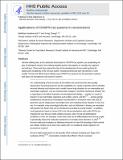Applications of CRISPR–Cas systems in neuroscience
Author(s)
Heidenreich, Matthias; Zhang, Feng
Downloadnihms791906.pdf (1.110Mb)
OPEN_ACCESS_POLICY
Open Access Policy
Creative Commons Attribution-Noncommercial-Share Alike
Terms of use
Metadata
Show full item recordAbstract
Genome-editing tools, and in particular those based on CRISPR-Cas (clustered regularly interspaced short palindromic repeat (CRISPR)-CRISPR-associated protein) systems, are accelerating the pace of biological research and enabling targeted genetic interrogation in almost any organism and cell type. These tools have opened the door to the development of new model systems for studying the complexity of the nervous system, including animal models and stem cell-derived in vitro models. Precise and efficient gene editing using CRISPR-Cas systems has the potential to advance both basic and translational neuroscience research.
Date issued
2015-12Department
Massachusetts Institute of Technology. Department of Biological Engineering; Massachusetts Institute of Technology. Department of Brain and Cognitive Sciences; McGovern Institute for Brain Research at MITJournal
Nature Reviews Neuroscience
Publisher
Nature Publishing Group
Citation
Heidenreich, Matthias and Zhang, Feng. "Applications of CRISPR–Cas systems in neuroscience." Nature Reviews Neuroscience 17 (January 2016): 36-44 © 2016 Macmillan Publishers Limited
Version: Author's final manuscript
ISSN
1471-003X
1471-0048